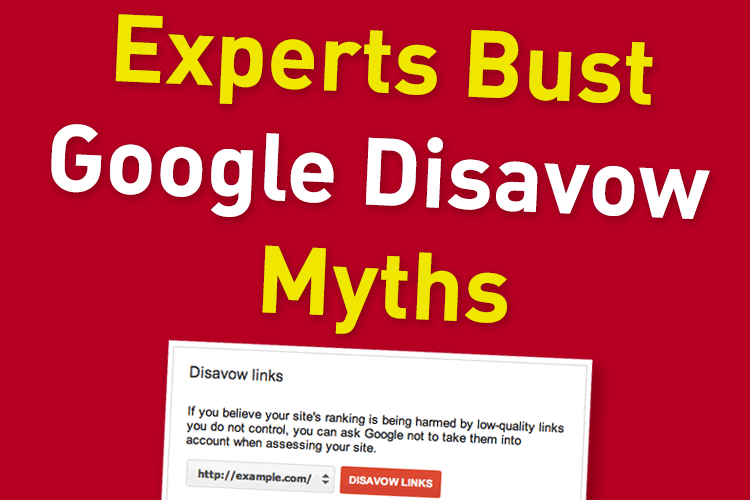Google wants us to use the disavow tool when we get a notice from them telling us we have websites pointing dodgy links at us. Although this would seem like a straight forward task, there are some myths and elements of confusion that have built up around using the disavow tool.

As there are numerous people who are far more experienced and expert on this subject, I decided to ask a few. Here is what they said. I asked:
What do you think the myths of using the Disavow tool are and what is the thing that most people seem to get wrong?
 Mark Porter
Mark Porter
@markcporter ScreamingFrog.co.uk There does seem to be a few misconceptions around the disavow tool recently that, based on our experience, simply aren’t the case. The main ones for me are:
Myth – You always experience a recovery after using the disavow tool
Unfortunately this simply isn’t the case. While it is dependent on the current situation (if it’s a manual action or algorithmic, such as penguin), we’ve found that it largely depends on what genuine, reputable links the site has, aside from the unnatural links that are being disavowed. If the domain does not have the backlink profile to support itself once these unnatural links have been disavowed then you are unlikely to experience a full recovery. It may be that these unnatural links were the only reason the site was ranking in the first place, in which case you’ll probably tumble away into the dark depths of Google.
Myth – You should ALWAYS disavow at domain level
While this may be true 95% of the time, there are some exceptions where it doesn’t make sense to disavow a link at domain level. For example, perhaps you have a client who used to send out press releases with multiple anchor text links in them, which got picked up or syndicated on a decent high value site. It’s usually best to disavow these at URL level in case they receive natural pickup from these sites further down the line.
Myth – You can pick and choose your links
“I believe this was one of the arguments on why the disavow tool shouldn’t be used in a recent moz post. The disavow tool is not there for you to select which links are helping or hurting the sites, regardless of how natural or unnatural they are. Links should be audited based upon whether they are meeting Google’s guidelines or not. Unnatural links which are undoubtedly helping a site may have to be disavowed to avoid problems in the future – you have to take it on the chin and move on!”
Myth – You have to make an effort to remove links
Again this is somewhat dependent on whether the site has a manual action or algorithmic, but we’ve found that just using disavow tool is sufficient and that no efforts need to be made repeatedly trying to get links removed from sites.
 Krystian Szastok
Krystian Szastok
@krystianszastok Rocketmill.com Some people (including me at the very early stages) used to believe that people read disavow files, so I used to put comments explaining why certain domains were disavowed.
What’s the thing that most get wrong: Disavowing at link level.
Most websites – especially the spammy ones – will give you many links from the same domain. Directories are a good example, you get a link from your listing and from any type of a category page. Lesson: always disavow at domain level.
One more thing many get wrong: trying not to disavow all keyword rich anchor text links.
If you got penalized – you need to disavow any suspicious link out there, otherwise your chances of getting out are slim. Getting out of a penalty at the first try is a skill. One doesn’t really do it without any past experience. Any number of software can dictate to you which links are bad and which are good. I use Cognitives Link Navigator which allows me to manually go through each link – one per domain – and review them by my own eye. I judge each link on the basis of ‘does this link have purpose other than giving me some tiny little bit of PageRank’. If the answer is ‘yes’ then the link usually stays. If the answer is ‘no’ – I remove it.
 Marie Haynes
Marie Haynes
@Marie_Haynes hiswebmarketing.com
I think that the biggest myth out there when it comes to using the disavow tool is that it doesn’t work.
I have seen so many people say, “I used the disavow tool, and my rankings did not improve, so it does not work!” But, there are many other factors that can be in play. For example, perhaps the site had very few good links and was only ranking well previously because of the power of links that are now being considered unnatural. Or maybe they disavowed the wrong links. Or perhaps the site is also dealing with other issues such as suppression by the Panda algorithm. I have seen many sites who have escaped Penguin, or have had a manual link penalty removed, who would not have been able to succeed without using the disavow tool. In my opinion it is a vitally important tool that needs to be used by any site that is suffering because of the presence of unnatural links.
Another myth surrounding the disavow tool is that you can do damage to a site by disavowing it.
If I disavow my competitor I am not going to do any harm to my competitor’s site. I’m just going to ask Google not to count any links from their site to mine when it comes to calculations for algorithms like Penguin. I do not believe that Google crowd sources data and says, “Ah! This site has been disavowed by many people. Let’s penalize it!”
And a third misconception about the tool is that it is read by the webspam team.
I see a lot of cases where the disavow tool was used with the intentions of it being a reconsideration request. In these cases, the first line of the disavow file contains a comment that says something like this: #We contacted all of the sites below and tried to get links removed but could not. Please reconsider our site as we are not ranking well because of past SEO link building efforts. However, disavow files are completely machine read and will not be seen by a Google employee. The comments in the file are really for your own use to make it easier to understand changes you make as you continually update the file. What do people most often get wrong when using the disavow file? I think that the most common mistake that I see is that the wrong links are disavowed. The most common reason for this to happen is that too much reliance has been placed on an automated link auditing tool. These tools can be useful when used in conjunction with a manual link by link audit. But, if you are running an automated report and going straight to disavow then you are definitely missing unnatural links and there is also a decent chance that you will disavow good links.
I think that the disavow tool can be extremely helpful if used correctly.
 Chuck Price
Chuck Price
@ChuckPrice518 reconsideration.org This is a great question, as there are very few tools that have generated as much FUD as this one. The most common misconception is the disavow tool doesn’t work. It does. For a manual penalty, the disavow file works, when used as a last resort, That means that a full fledged and well documented link removal campaign must precede it. The disavow file, combined with a detailed reconsideration request, is a core component in successfully getting a manual penalty revoked.
For an algorithmic hit (Penguin), the disavow file also works.
What “most” people get wrong is that a manual link removal effort is NOT required.
In fact, manual link removal is a waste of resources. Since most link removal campaigns result in 5 – 10% of the links being removed, it is generally not enough to move the dial.
The Penguin algorithm is driven primarily by a good link to bad link ratio. Your time is better spent replacing the disavowed links with good ones.
Another point most people get wrong is their expectation for what a “recovery” looks like.
Many people expect that a recovery means regaining their former SERPs after they have escaped a manual penalty or algorithmic hit. Since many of the links that once propped up SERPs are now in the disavow file, that’s not going to happen. At least not until those links are replaced with good ones.
 Gabriella Sannino
Gabriella Sannino
@SEOcopy level343.com Oo dear, dare I say I never heard of the “myth” rather opposition to the action? We’ve used the disavow process with several clients who had either been penalized or we took proactive measures when we noticed a large amount of toxic links. Granted you can’t say definitively that any recovery came directly due to the disavow process, however, they (clients’ sites) show signs of recovery when we’ve done them.
In regards to what people seem to get wrong is their disavow specific links rather than a domain.
In our case, when we have proactively used the disavow tool (without having been manually penalized), I would say results are inconclusive, but show STRONG correlation. But I would still advise and recommend doing it as part of any link profile clean-up.
 Rusell Jarvis
Rusell Jarvis
@russelljarvis travelstart.co.za Three most common myths:
Myth 1: Submitting links for disavowing guarantees that your site will be out of the red for link malpractice immediately.
Reality: If your site has been negatively impacted by penguin you generally have to wait until Google crawls all the domains requested and wait for the next penguin update to roll out before seeing full recovery in SERP visibility. If you have been hit by a manual penalty it usually takes a lot more work than just submitting domains to be disavowed. Manually removing spammy links to your site trumps disavowing links.
Myth 2: Using the disavow tool flags your site as using spammy link building practices to Google.
Reality: This is untrue. Google does not flag your site as spam for using the disavow tool. They are usually very good with picking up unnatural link activity and will probably hit you with a manual penalty on detection. Same goes for having your domain submitted in another sites disavow list, remember links that may seem unnatural for some sites can be more natural for others (it depends on industry, content, context and a bunch of other factors).
Myth 3: Once you disavow links there is no going back.
Reality: This is untrue as Google has confirmed that it is possible to reavow links. You simply have to remove links from the disavow list and resubmit it. However, reavow requests take much longer to be recognized as Google takes even stricter precautionary measures in this process to aid combating spammers who are trying to find loopholes. They usually crawl a domain a couple of times before revoking the disavow request. On the topic of resubmitting a disavow list, remember that when you submit a new list in the tool it overrides the old list. Thus, always work from the original list and update it. You can also add comments between using hashes (#–add comment— #) to the file to make notes for yourself and other webmasters that may need the info in future. Don’t rely only on tools to classify your links as spam or quality. Nothing is more accurate than the eye and instincts of an experienced search engine marketer. It may be a tedious task working through hundreds or thousands of links and categorizing their quality, but I guarantee it’s worth the time and effort. Disavowing too many links (including good quality links) is just as dangerous as disavowing too little. In short, marketers shouldn’t test the disavow tool … it should be used only when necessary. It is not there to clean up after the mess of knowingly dodgy link building practices.
 Emory Rowland
Emory Rowland
The worst and most deceptive myth is that uploading a list of unsavory domains with the disavow tool gets you out of jail.
Why would Google want you to do just this? Consider the absurdity of this cycle. You build links. Get a short term boost. Blame it on spammers. Disavow. Build more links. Rinse and repeat. Soon someone creates automated disavow software. So, you no longer even have to think about the consequences of bad links, just click the auto disavow button. Somehow, people forget that the point is to lose the links. And Google is taking account of the ones that fall off. The disavow tool doesn’t prove your motivations. Actions speak louder than disavows. Get it right the first time by disavowing and losing links.
 David Cohen
David Cohen
@explorionary In my experience, I believe the worst Disavow Tool myth of all is that you must remove some or all links in order to restore the organic search visibility and traffic that’s been lost because of a Penguin-related issue. Using the Disavow Tool and blindly removing links on a wholesale scale isn’t a smart and strategic approach to solving the problem, it’s sloppy.
It’s not a myth that you can successfully use the Disavow Tool, not remove links, and experience a restoration of what’s been lost.
Pure opinion – but I feel the last step you’d ever want to take is actually removing links to your site as part of the entire disavow and restoration process. The best way to both avoid the myth and avoid making your site perform worse is to hire a professional who has a proven track record of solving your Penguin-related problem. Using amateurs will always end up costing you more than using professionals in this scenario.
Conclusion
I would like to thank all those who took part in the expert round up for taking the time to participate as I know we all get very busy. As we can see there are some very interesting issues raised here by our panel of experts.
While some people disagree with certain techniques regarding the disavow tool, one thing is certain, you have to be careful and you have to know what you are doing.
If I can make a shameless plug here, cognitiveSEO has a very useful unnatural link detection tool that will help a lot in the disavow process. You may also be interested in these further articles regarding the disavow tool: Unnatural Links & Penguin Recovery using the Google Disavow Tool Google Penalty Recovery Using the Disavow Tool – [Manual Action & Penguin 3.0 Refresh]

 Site Explorer
Site Explorer Keyword tool
Keyword tool Google Algorithm Changes
Google Algorithm Changes Mark Porter
Mark Porter Krystian Szastok
Krystian Szastok Marie Haynes
Marie Haynes Chuck Price
Chuck Price Gabriella Sannino
Gabriella Sannino Rusell Jarvis
Rusell Jarvis Emory Rowland
Emory Rowland David Cohen
David Cohen

What proof do these people offer to prove their claims?
(read: none)
The “I’ve seen it work” proof is no proof at all.
And they say *I* sell snake oil….
Josh – I definitely never said that you sell snake oil as I’ve never met you or commented on your practices.
I don’t sell anything, I just share my experiences – as I think others are doing.
The only proof I have is my experience, which I’m sharing for free trying to help others, as I know I sure needed that help a few years ago when this all started.
DISAVOW WORKED FOR ME
Here’s a real life story.
I lost all Google ranking on one of my most popular pages in March 2017. I discovered multiple spammy links to that page, disavowed them and 10 days later that page reappeared in ranking. I’d say it regained about 90% of it’s former ranking.
I spend days reaching out to all of the websites that I had negative backlinks to and only one responded, the one with the most links actually. But he clearly didn’t know what he was doing, because while he attempted to remove the links, they’re still there. (How does one know how to create a link, but not remove it?!) At any rate, all of the links I disavowed still appear in Search Console (as expected), but Google is not counting them against me.
The End 🙂
Thanks for the insights, Jenna! 🙂
Hackers are real and very helpful, the government uses hackers to win votes. I know of a proffesional hacker “HACK dot CYBERCRAWLER at GMAIL dot COM” he is the notorious Hacker the CIA is looking to Hire
contact him today to get your job done.
Josh, what type of proof are you referring to or looking for? I contributed to this because I have done the work, not “seen the work”. In my response I use the words pure opinion to qualify everything I say that follows after those words. And unless Google begins clearly stating something to the effect of… here’s why your site was devalued, here’s what you did to raise it’s value, and here’s why that worked, can there really be any definitive “proof” at all?
Josh, there are many opinions out there, as many as there are people. These are some opinions from people who not only work in the space, but have worked for quite some time in the space.
That counts for something.
This disavow tool creates something of a discussion amongst people who I deem as experts. Two experts may disagree on the same thing and yet still be right, I’ve seen this happen a number of times.
But then I have been around for quite some time.
Proof, or 100% proof is an interesting concept. If we had it, we wouldn’t need opinion or some ones take on an issue. Sometimes you have to figure things out yourself and have others who have gone before you lead the way.
The experience people in our community can lead us to where we want to get to.
If unquestionable proof could exist, it would negate the need for opinion. I don’t need someone to tell me water freezes at 0 degrees, I can prove it myself.
But the disavow tool is interesting as it creates different camps of thought. I quite like that as it brings together members of the tribe to share their experience and stories. And from this we learn.
This is that situation now.
We sit
We listen
We learn
And then we add our thinking to the tribe.
Hopefully, we all get to the place we want to be.
Thank you for including me in this post Lyndon. I was asked to come and reply to Josh’s comments. I have to say that I had hesitation in doing so as I am not interested in stirring up another heated discussion. In the past when I have replied to Josh we have often had difficulty in having a mature professional discussion. I think that we may have to just agree to disagree and leave it at that.
The reality is that proving that disavowing alone is sufficient work to overcome Penguin suppression is something that would be very tough to prove without a shadow of a doubt.
I wrote an article where I gave examples of cases where either my company or another company had done just disavows and sites had made either a partial or full recovery from Penguin:
http://www.hiswebmarketing.com/can-escape-penguin-disavowing-alone/
But, how am I going to prove that we just disavowed and didn’t remove any links? Josh will tell you that if you look at any of these sites on ahrefs.com you will see that there is evidence of link loss. And this is correct. Sites that link out with spammy links often die and as such, any site that has an unnatural link profile is going to see evidence of link loss. But this does not mean that I went and removed links.
Now don’t get me wrong…if there are links that I can easily remove without spending a large amount of my client’s money then I will do that. For example, for a recent site that I worked on, they had a large number of links from free hosts like wordpress and weebly. We reported each of these as spam and those links were removed.
But, I don’t think it is worth it to spend weeks doing extensive email outreach and spending hours and hours to remove links rather than disavowing. I could personally make a lot more money if I did recommend this approach as there is a lot of billable time involved in doing this. But it doesn’t make sense to me to do so.
The vast amount of link audit work that I do these days does not involve link removal (unless there is a manual penalty).
But ah….I have said this over and over again. And it always comes down to the same argument:
Marie: I have seen sites make Penguin recoveries with disavowing alone.
Josh: Prove it!
Marie: Here are some sites for which we only did a thorough link audit and a disavow and they saw good improvement when Penguin refreshed.
Josh: But this site shows evidence of link lost so you are lying about not removing links.
Marie: Every site that has spammy links has evidence of link loss.
Really, nobody can say with 100% certainty what works for Penguin. I can say that for almost three years now, all of my income and the majority of my time has been spent trying to understand Penguin and help people who have been affected by it. I don’t claim to know everything about the algorithm. But I have many ideas and theories about what seems to be working. I always want to be open to suggestions and I think that discussions on what does and doesn’t work can be good provided that we can respect each other.
Josh is not my enemy. I think he’s got some really good ideas. I just wish that he wouldn’t be so confrontational when presenting them.
Lyndon, I really enjoyed this article. Thanks again for doing this.
Marie,
1) thank you for being professional in your response – seems some people wanted to make another disavowgate ;p glad we have disappointed them
2) small correction, i never said you were lying about engaging in link removals – i believe you when you say most times it’s not worth trying, and thus you didn’t bother, because in my experience you are right, you don’t get very many links removed and it costs money as people gouge you to remove the links!!!
my point is simply academic: i only question the logic and efficacy of selling and charging clients for any kind of disavow service, especially for and in this case regarding penguin, when there is no evidence that a pure disavow helps
whoever or whatever entities does sell such a service, or not, i don’t know, or care
however i know they exist, whether they wish now to admit it – they are, I assume, the bulk of the people now conducting my character assassination
google TCs being the other portion (which likely has more to do with my upcoming documentary vs. google)
it would be better to sell this hypothetical client a “change domain names and let’s built it up right”, as you would have more assurity to control that process than rely on an at best useless and at worst dangerous disavow process, that has no evidence to suggest works alone (and barely at all)
link deletion seems to help there, not the disavow
but that is hard if not impossible to do, as you mention
so seo’s are left selling and publicly defending a dubious disavow process
and their only recourse, instead of proving it works as i have challenged, is to vilify me, the challenger
I agree with this 100% – as we all know, link removal is damn near impossible when it comes to getting each and every link taken down that has a negative impact on your site, but at the same time, the disavow tool can only do so much.
I’ve been seeing people troll you all over the web lately, but they always seem to disappear when they are confronted with facts or asked to provide even a shred of evidence to support their claims.
What is even funnier is when you offer them a chance to come and meet you in person to participate in the filming and share their thoughts and opinions, they flat-out ignore your comments altogether.
There’s an old saying – “you can’t please everybody.”
Well, if this “disavowgate” crap has taught me anything, its that this saying is completely true!
“link removal is damn near impossible” – i have managed to remove a large proportion of links that I have disavowed. Most the of these links were removed by simply sending emails via online forms or emails on the website. The next stage is digging deeper and finding email addresses from whois. You can even get responses from websites who have privacy settings and you have to relay your link removal message through private domain proxy’s. However, no matter how hard or how many times you try to contact the last remaining hard line webmasters to get links taken down you are still not going to win if they have banned your email address or banned all email addresses that come from a certain area, e.g. a link I had removed recently took me over a year to do, the webmaster had basically banned or emails fromm reaching him originating from the UK. I know this because he told me on the phone when he finally gave me an email address that I could send my link removal request to. This leads me onto the fact, that the only way to chip away at the last remaining die hard webmasters and get links removed is unfortunately to call them. This might mean calling during the week, and calling them at the weekend when most of the these people are in. Taking account of the time difference if you are calling from other countries means this can become very much an inconvenience if you have to call someone on Saturday night to get hold of them beacuse they are 7 hours behind. They might be engaged or out too. I have had alot of success reaching out to webmasters who ignore my requests via email by actually talking to them and explaining my issue. There are however, those webmasters who hate Google and will not remove your link point blank, even if you offer money (too die hard). I’ve only met one of these. The effect of removing these disavowed links has seen my client stabilise quite considerably in the search results, and have seen huge ranking improvements for keywords that had disappeard. Overall the url is in a stronger more reactive mode to gain more momentum with fewer spammy links poiting to it. If you persist in getting links removed and keeping chipping away at webmasters you will get results, as long as you are always polite to webmasters you will have more success in getting spammy disavowed links taken down. I know because it has worked for me.
Josh, I have had many sites that came to me with penalties under Penguin. I disavowed the bad links, and almost all of them have recovered completely, and now rank again at the top of search. The ones that didn’t recover are the ones who kept buying links (or they claim a competitor did) or that don’t have enough natural links.
Why do you think disavowing doesn’t work? Have you tried and it didn’t work for you? What is your evidence? I’d really like to know.
Marie, thanks the long and insightful comment. I think you have a lot of knowledge and experience to share and I am grateful you took the time to share.
Myth #1
“The Disavow file has not been processed because I still see the links in Google Webmaster Tools link data”
Disavowing links does not make them disappear from Google Webmaster Tools. As long as they are still live links they will continue to be reported. The only way to get a real insight into whether a disavow instruction may reasonably have been processed is to check whether the Google cache has been updated since the date the disavow was lodged. This was discussed by John Mueller and expanded upon in a post by Marie some time ago, but I still get people calling me and railing at the fact that their disavowed links are still visible in lists downloaded from GWMT.
Myth #2
Using the disavow tool to do as little work as possible and expecting sustainable results is the way to go.
This is where I respectfully disagree with Marie. While disavowing is certainly the go-to solution for dealing with an algorithmic effect, it remains a band-aid solution. As in real life, sooner or later the band-aid is going to lose its effectiveness and maybe even fall off.
Leaving unnatural links in the backlink profile leaves it vulnerable to future changes in the algorithm, negative seo attacks and damage to the brand by competitors who choose to call out the company for bad linking practices. I believe it also detracts from the power of the great links in the profile. Which brings to mind another myth of link removal practitioners.
So sick of hearing people justify poor effort by carping on about it being reasonable to expect no more than 5-15% cleanup in a link removal campaign. Frankly, if you’re prepared to settle for that you should do yourself and your clients a favor and go work in another niche.
With a creative mind, the right attitude and the right tools it is reasonable to expect at least 40% cleanup for the majority of affected domains.
Dangerous Myth #3
“Only disavow domains where links could not be removed”
Not including domains that have removed unnatural links in a disavow file is a bad idea. There are two major reasons for this:
1. Links do come back for a variety of reasons. If you have not disavowed because you thought the links were gone you are right back where you started WITH the added problem of appearing to the Webspam team as though you might have temporarily hidden those links to get past a penalty.
2. It is extremely unlikely that you know about all of the links on a site. If you ask the domain owner to remove the links you know about and they comply, but there are more links on the site, you have solved nothing.
As pointed out by Fili Wiese a long time ago, if you did not want links from that domain linked to your site, you should be disavowing the domain anyway.
Let the onslaught begin 😉
tks for sharing your experience Sha 😉
from what I can see the experiences overlap 80% which means that something must be working 🙂
in my own experience seeing how the people use the cognitiveSEO unnatural link detection tool and their feedback once they do the disavow I saw both Penguin and Manual penalties recovered (lots of them).
Human intervention is always required when generating the disavow file. Looking at each individual referring domain, or where the case at multiple links from the same referring domain and disavowing based on that.
Trying to trick Google with partial disavows does not work. just my experience 😉
I see a LOT of terrible advice on disavows. I’ve said as much on many forums in the past. That being said, the above information is almost entirely, 100% excellent information! I really like this post and will use this as my new “myth” go-to post.
Josh – my “proof,” should I ever feel the need to display & use it to convince someone else of my data, includes data from over 1000 disavows that I’ve completed myself. We have as much data as I believe is possible to have on this topic. I’ve seen recoveries, non-recoveries, recovery before Penguin updated, recoveries at the Penguin refreshes and recoveries based on small, medium and large disavow files.
You posit that you “can’t disavow out of Penguin.” As I commented on your Moz post, that is true but the *appearance* of it is possible for a couple different reasons.
You said: “i only question the logic and efficacy of selling and charging clients for any kind of disavow service, especially for and in this case regarding penguin, when there is no evidence that a pure disavow helps”
This I STRONGLY disagree with. You are missing the point, unfortunately. I agree with your premise AND your conclusion but can’t get on board with your argument, which is frustrating. Disavow-only services are great because many SEOs aren’t very experienced with disavows. You would rather someone book SEO services where the SEO is talented at link building & hasn’t done a disavow before simply because it’s holistic? I would rather get the expert to do the disavow and then another expert do my outreach, content & link building. Why wouldn’t you want the best/most experienced disavow people working through your link spam?
Anyhoo – once again, great post. I really think this is a fairly complete collection of Myths and the truths behind them. My only disagreement is Rusell’s contention that “wait for the next penguin update to roll out before seeing full recovery” = this isn’t true. Disavow, build NEW strong links = better rankings than ever. Done that many, many times. But sometimes this is correct. We had a lot of HUGE jumps at Penguin refresh so it does work that way but not always.
Matt, based on your comments you sound like the type of professional I refer to in my response.
Penguin is stressful for people, especially eComms who’ve built their business on the back of Google (rightly or wrongly), So it’s best for clients to work with a calm, logical thinker who has a track record of success to do this type of work.
From now on I will direct people who need to hire someone to solve their Penguin issues to read your comments and the others here so they can get a feel for the different types of people who do this work. A lot about someone’s personality is revealed in the way they write and respond to differing views.
I think Matt has pretty much nailed it with this response. I think it’s important to highlight that the above is based on our experiences, and it’s always interesting when people have experienced differing results 🙂
Anyway, thanks for letting me get involved Lyndon/Cognitive!
our pleasure Mark. keep up the good work!
Hey Matt! Nice bumping into you again!
I am on also on board with your suggestion about not needing to wait for the next penguin update to see a good recovery. There have been a number of occasions where I have seen a websites traffic soar up in less than 6 weeks of a disavow and there was no penguin update. I can also tell you that this had nothing to do with link building because in one example one client did not have the budget to replace these with better links.
I am also currently working with a client who got heavily penalised in the past. After the initial big disavow I continue to disavow ‘toxic’ links each month as new links are always being discovered by the tools recently which were built many years ago. But hey, guess what? It is working and we will continue to disavow these links each month! That is my proof, however I guess each case is different.
Hey Lyndon
Thanks for the opportunity to participate in this discussion.
You have assembled a number of SEO’s with a lot of experience using the disavow file. There is not much, if any disagreement, among those polled as to how it works. When you have this many experienced professionals reaching consensus, there’s a pretty good chance that the information shared here is “right.”
Thanks for taking part Chuck.
I think we assembled a very high level bunch of people who shared the current thinking and best practice regarding this issue.
There is a lot a chatter around this issue, but our aim is to distil, filter, curate the best advice from the best people, and I think we have done this here.
Wow, I wanted to swing by earlier to partake in this discussion, but it’s been crazy around here. I see Marie Haynes has addressed a few points I was going to make.
At the end of the day, the disavows we did on behalf of the clients have not harmed them. If anything, looking for Jersey’s on a Big Data website would not only be bad for business, but it just doesn’t make sense. Furthermore we were never hired just “for” a disavow project- we’ve always been proactive when looking at link profiles for clients. We painstakingly and manually went through each link prior to using the disavow tool. Period. It’s in our client’s best interest and that’s how we roll 😉
tks for jumping in the comments section Gabriella and for participating in the group interview 😉
your opinion matters and as we saw lot of the shared opinion overlap in terms of best use practices.
Many business owners and SEOs seem a bit trigger-happy when it comes the use of the disavow. If you are worried about the profile and how future-proof it may be, then going straight for the disavow is not always the best thing to do.
“Myth – If you see a bad link in the backlink in the profile, just disavow it.
When it comes to qualifying the links and identifying what a bad link actually is, there are many cases where the link could be categorised as bad due to the anchor text. In these instances, many an SEO will simply disavow the link at domain level. If the content the link is included in is good, then a brief email to politely let the editor/webmaster know that you would like the anchor text amended can yield some great results. This way you retain the value of the linking domain and remove the risk of the anchor text link.
“Myth – we want to hold off on the disavow because we want to invest X amount into outreach first to every single site that has a bad link pointing to us”
You need to know which sites feature a bad link and won’t respond to your emails asking for amendments. Most directory sites as well as blogs that are no longer publishing content will not amend your links as a favour. In these case you can disavow these types of sites first, before manually trying to reach out to sites you are confident will respond.
tks for your addition to the myth list Tom.
it is going to be interesting to see what works when Google Releases the Realtime Penguin Update.
Thanks for your input, very interesting.
I have to disavow about 500 links for a customer (about 100.000 backlinks total) because of bad quality, mostly blogs that are left 5 years ago. Contacting the site owners did no effect, they don´t read their old blogspot or blogger emails any more.
We´ll see if that has an impact in visibility.
I have used disavow tool many times and I find that it only has effectiveness when/if you are hit with Penguin. In NO other case should you use it.
If you were not hit with Penguin and you use disavow, 99% of the time your site will drop. This is my experience with many websites.
This is great, a much needed and powerful article, especially since you have so many experts weighing in with similar views. After reading it, it would be difficult to entertain the myths any longer. I’m always surprised when people tell me that disavowing doesn’t work so vehemently. Now I have something to show them: a link to this post!
I often use the disavow tool with clients and have used it successfully with both Penguin and for manual penalties. Now that Penguin is part of the core, recovery times are quicker.
I found out early that removal and commenting isn’t necessary. Many experts at conferences and workshops say it is required. I think this is irresponsible because some poor schmucks are going to follow that advice and waste hours and their clients’ money to remove and comment on links. Thank you for clearing this up!
I’ve used the disavowal tool for hacked sites with thousands of bad incoming links from other hacked sites with anchor texts for viagra or payday loans. Being able to disavow at the domain level makes disavowing much easier and faster, since it usually means typing hundreds of domains instead of thousands of links. However it is still a chore typing hundreds. I’m always surprised to see the hacked sites getting a manual penalty, often after the site is cleaned up, since it is not the website owner’s fault.
Anyway thank you so much.
I am continuously using disavow tool from last six months. Everyday more than 400-600 spammy-irrelevant links are created to my site. I don’t know who is doing this. So i have to update the disavow file most frequently.
Honestly, some of the mixed opinions/experiences make things more confusing. Things like disavowing at link level or domain level. Opinions I am pertaining to not only come from this article but from other posts about the google disavow tool. I’ll need to do more reading on this.
Thanks Lyndon 🙂
This is the one I run into most often (from Marie) “And a third misconception about the tool is that it is read by the webspam team.”
I too thought like the experts above. Now I question assumptions which may have been righr pre-groundhog update. The scale of the projects are crazy. 100’s of thousands of links and 100’s of domains.
I noted huges rises in rankings (across different KW’s in different KW silos that use different CMSes (yes you read that right), and parts of the site are greatly unoptimised due to technical differences with the CMSes. The sites are not optimised with HTTPS, mobile enabled nor have great site speed.
We did various disavows. One, a few weeks before the groundHog update. The other just before the unexplained update in November last year.
Since Groundhog rankings have held and got better since. Obviously other activities are being done but they are disadvantaged.
I used to think the same – no rank boostings. However I’m a bit taken back by these massive rises. I’m open if I’ve missed something, but I hope to stimulate chat and find out more from your experiences.
Thanks for your input, Anthony! I think that, just like in most of the cases, we can best learn from case studies.
Different people have given different opinions in this article. Many of the mentioned myths are indeed myths (like always disavow at domain level and Google’s team reads the disavow file). But one thing is there for sure: Disavow Tool works! If it is not working in a given example, the reason lies somewhere else. You can not blame it on Disavow Tool. A website may face scores of SEO issues, bad backlinks is just one of them.
Some myths still work some don’t. I’ve experienced that the disavow tool really can help you from negative impact of any bad links (naturally or unnatural onces).
However, just use disavow tool rarely made your website or page #1 on SERP. Its maximum potential is to prevent your sites from falling down because of such bad links. To get #1 on Google is another thing.
The disaster that Google Disavow has created is that they “Built an arena where SEO war can be waged” on large and small domains, with suspecting SEO admins and totally unaware small business owners.
How did Google not anticipate the devastating effects this could cause to small business owners? Completely unaware of a Black Hat SEO team that has targeted their domain or simply doing something to their site that is an unknown secret Google no-no.
Other problems. When a link list exceeds 100 or 1000 links the job of managing new links is a ridiculous time waist and another huge financial burden on small businesses.
My perception of this tool, if not clear by now, is that it can help large business with budgets for SEO Pros that understand how this works, or it can put small business out of business by giving a Black Hat tool to the competition.
Google has all the tech needed to manage and mitigate link without the Disavow Tool.